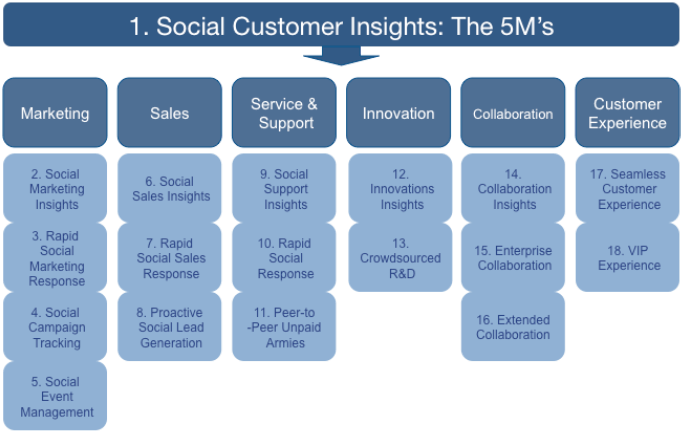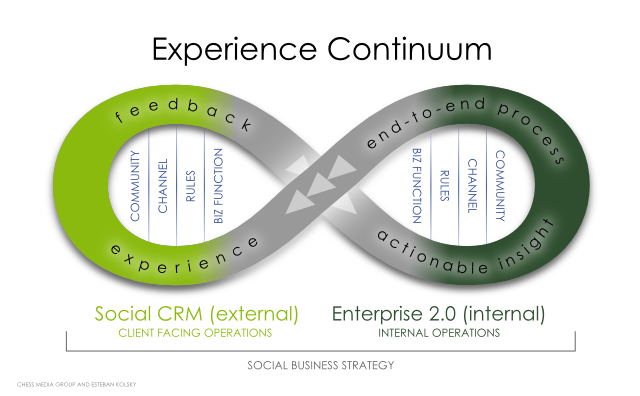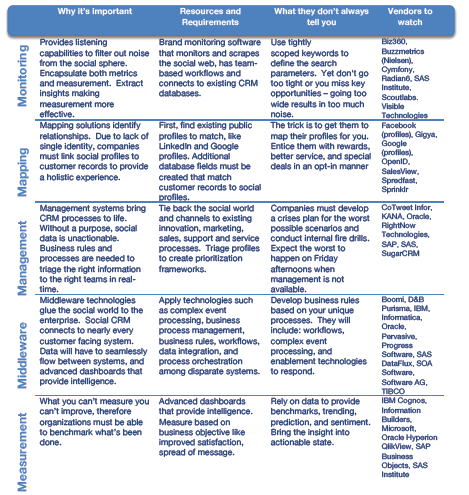Jeremiah Owyang and Ray Wang from Altimeter Group released their report today on the 18 use cases for Social CRM and provide some ideas and guidelines for how to move forward within the space. They included quite an impressive roster of experts and vendors to help them compile their report. However, keep in mind that what they created is just a starting point. I just finished re-reading the report again and I think what they have put together is a great document but I do have some ideas, thoughts, and notes on what they put together.
Let’s start with this image that depicts the 18 use cases of Social CRM:

Traditional CRM has always been used for three things: sales, marketing, and customer service. Social CRM doesn’t replace those but instead it adds new layers into the mix (as you can see from the image above), mainly collaboration, ideation, and improved customer experience. Actually, I wouldn’t even classify customer experience as a separate SCRM layer because I think the whole point of SCRM as a whole is to improve the customer experience. Collaborating with customers, innovating, and improving your marketing, sales, and support efforts are all geared towards improving the customer experience because that is ultimately what is going to be the key differentiating factor between competitive companies.
I’ll point everyone to the following idea that Esteban Kolsky came up with (Chess Media Group helped redesign it). Again this image shows the overlap between Enterprise 2.0 and Social CRM.

Back to the report…
Jeremiah and Ray researched 18 use cases for Social CRM but I’m sure others will emerge quickly (or may already exist).
The report also goes on to discuss the 5 Ms of Social CRM and the baseline processes.
What I would have liked to see is a separation between what can be automated and what needs to be handled by a human. I have a baseline framework for this that I brainstormed with Brent Leary and hopefully I can create an image that depicts what that should look like. The other challenge here is that Jeremiah and Ray recommend that we need all 5 Ms yet each M involves working with a new vendor. According to the baseline process chart, in order to fully take advantage of SCRM a company would need to work with at least five different vendors such as Biz 360, Facebook Profiles, Sugar CRM, Informatica, and IBM Cognos. I don’t think that this is realistic and then there’s the issue of integration and of course budget and resources (yes I know, a completely separate issue).
I definitely commend Jeremiah and Ray for really compiling a fantastic report (there is much more in there for you to read). I think this report is a fantastic starting point for the SCRM framework, and while I’m sure not everyone agrees with what they (or I) have to say about SCRM, it certainly will cause great discussions to surface. If you want to check out the full Social CRM report, you can visit the Slideshare presentation (which I recommend you do) or just read below.


Jacob thanks for the review. Good point about automation for manual processes, in most cases, the goal is to automate to increase scaling and efficiency, but we know from brand monitoring, community management, and collaboration use cases –that's never truly going to happen till someone develops skynet.
Regarding the vendor requirements for the 5Ms we've not seen a single company tackle all 5Ms, and when we do, we would want to highlight them. To date, the process is disparate in a new market, this is one of the realities in an emerging market: Many players, ideologies, and data types.
Again, Thanks.
Jacob thanks for the review. Good point about automation for manual processes, in most cases, the goal is to automate to increase scaling and efficiency, but we know from brand monitoring, community management, and collaboration use cases –that's never truly going to happen till someone develops skynet.
Regarding the vendor requirements for the 5Ms we've not seen a single company tackle all 5Ms, and when we do, we would want to highlight them. To date, the process is disparate in a new market, this is one of the realities in an emerging market: Many players, ideologies, and data types.
Again, Thanks.
Pingback: Join the Social CRM Pioneers!
I’m just grateful for your help and in addition have high hopes you are aware of a great job you’re undertaking training some other people using a blog.
This must be really exciting stuff to consider, looking forward for more.
Good point about automation for manual processes, in most cases, the
goal is to automate to increase scaling and efficiency, but we know from
brand monitoring, community management, and collaboration use cases.
It’s a great document but I do have some ideas, thoughts, and notes on what they put together.
Thank
you for all your efforts that you have put in this. Very interesting info.